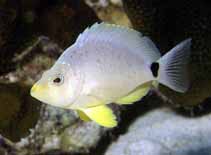http://www.fishbase.org/Summary/speciesSummary.php?genusname=Hypoplectrus&speciesname=unicolor ---> http://192.134.151.83/Summary/speciesSummary.php?genusname=Hypoplectrus&speciesname=unicolor
http://192.134.151.83/Summary/speciesSummary.php?genusname=Hypoplectrus&speciesname=unicolor ---> https://fishbase.mnhn.fr/Summary/speciesSummary.php?genusname=Hypoplectrus&speciesname=unicolor
https://fishbase.mnhn.fr/Summary/speciesSummary.php?genusname=Hypoplectrus&speciesname=unicolor ---> https://fishbase.mnhn.fr/summary/Hypoplectrus-unicolor.html
Hypoplectrus unicolor, Butter hamlet : aquarium

You can
sponsor
this page
Common name (e.g. trout)
Genus + Species (e.g. Gadus morhua)
-

-
About this page
-
Languages
-
User feedbacks
-
Citation
-
Uploads
-
Related species
-


 Butter hamlet
Add your observation in
Fish Watcher
Upload your
photos
and
videos
Butter hamlet
Add your observation in
Fish Watcher
Upload your
photos
and
videos
Pictures
|
Videos |
Sounds
|
Google image
 Hypoplectrus unicolor
Hypoplectrus unicolor
Picture by
Patzner, R.
Teleostei (teleosts) >
Perciformes/Serranoidei
(Groupers) >
Serranidae
(Sea basses: groupers and fairy basslets)
Etymology:
Hypoplectrus:
Greek, hypo = under + Greek, plektron = sting, spur (Ref.
45335
)
.
More on author:
Walbaum
.
Environment: milieu / climate zone / depth range / distribution range
Ecology
Marine; reef-associated. Tropical; 32°N - 6°N, 99°W - 56°W
Western Central Atlantic: Florida (USA), Bahamas and throughout the Caribbean. Absent from the Gulf of Mexico.
Size / Weight / Age
Maturity: L
m
?
range ? - ? cm
Max length : 12.7 cm TL male/unsexed; (Ref.
13442
)
Adults pale yellow; usually darker dorsally; grayish yellow that pales ventrally. Iridescent blue dorsal-ventral lines on head, sometimes extending to the leading edge of pelvic fins. One distinct blue line encircles the orbit and extends ventrally on each side of the fish. Two black pigment spots are sometimes found on the snout region of the nares. A large black saddle on caudal peduncle, extending below the lateral line on each side of the fish. Pelvic fins yellowish, pectorals clear.
Mainly carnivorous (Ref.
13810
). Has been reared in captivity (Ref.
35420
).
Life cycle and mating behavior
Maturity
|
Reproduction
|
Spawning
|
Eggs
|
Fecundity
|
Larvae
Domeier, M.L.
, 1994. Speciation in the serranid fish
Hypoplectrus
. Bull. Mar. Sci. 54(1):103-141. (Ref.
26407
)
IUCN Red List Status (Ref.
130435
)
Least Concern (LC)
; Date assessed:
21 August 2012
CITES
Not Evaluated
Not Evaluated
Threat to humans
Harmless
Human uses
Aquarium: commercial
FAO - Publication:
search
|
FishSource
|
More information
Countries
FAO areas
Ecosystems
Occurrences
Introductions
Stocks
Ecology
Diet
Food items
Food consumption
Ration
Common names
Synonyms
Metabolism
Predators
Ecotoxicology
Reproduction
Maturity
Spawning
Spawning aggregation
Fecundity
Eggs
Egg development
Age/Size
Growth
Length-weight
Length-length
Length-frequencies
Morphometrics
Morphology
Larvae
Larval dynamics
Recruitment
Abundance
BRUVS
References
Aquaculture
Aquaculture profile
Strains
Genetics
Electrophoreses
Heritability
Diseases
Processing
Nutrients
Mass conversion
Collaborators
Pictures
Stamps, Coins Misc.
Sounds
Ciguatera
Speed
Swim. type
Gill area
Otoliths
Brains
Vision
Tools
Bio-Quiz
|
E-book
|
Field guide
|
Identification keys
|
Length-frequency wizard
|
Life-history tool
|
Point map
|
Classification Tree
|
Catch-MSY
|
Special reports
Check for Aquarium maintenance
|
Check for Species Fact Sheets
|
Check for Aquaculture Fact Sheets
Download XML
Summary page
|
Point data
|
Common names
|
Photos
Internet sources
AFORO (otoliths) |
Aquatic Commons
|
BHL
|
Cloffa
|
BOLDSystems
|
Websites from users
|
Check FishWatcher
|
CISTI
|
Catalog of Fishes
:
genus
,
species
|
DiscoverLife
|
DORIS
|
ECOTOX
| FAO - Publication:
search
|
Faunafri
| Fishipedia |
Fishtrace
| GenBank:
genome
,
nucleotide
|
GloBI
|
GoMexSI
(interaction data)
|
Google Books
|
Google Scholar
|
Google
| IGFA World Record |
MitoFish
|
National databases
|
Otolith Atlas of Taiwan Fishes
|
Public aquariums
|
PubMed
|
Reef Life Survey
| Socotra Atlas |
Tree of Life
| Wikipedia:
Go
,
Search
| World Records Freshwater Fishing |
Zoological Record
Estimates based on models
Preferred temperature (Ref.
123201
): 25.6 - 28.2, mean 27.4 °C (based on 530 cells).
Phylogenetic diversity index (Ref.
82804
): PD
50
= 0.5000 [Uniqueness, from 0.5 = low to 2.0 = high].
Bayesian length-weight: a=0.01778 (0.00680 - 0.04650), b=3.03 (2.80 - 3.26), in cm total length, based on LWR estimates for this (Sub)family-body shape (Ref.
93245
).
Trophic level (Ref.
69278
): 4.0 ±0.65 se; based on food items.
Resilience (Ref.
120179
): High, minimum population doubling time less than 15 months (Preliminary K or Fecundity.).
Fishing Vulnerability (Ref.
59153
): Low vulnerability (10 of 100).
Nutrients (Ref.
124155
): Calcium = 86.1 [46.0, 180.4] mg/100g; Iron = 0.676 [0.349, 1.314] mg/100g; Protein = 18.1 [16.2, 19.9] %; Omega3 = 0.133 [0.075, 0.229] g/100g; Selenium = 23.2 [12.2, 48.5] μg/100g; VitaminA = 101 [26, 450] μg/100g; Zinc = 1.31 [0.82, 2.02] mg/100g (wet weight);
Back to Search
Random Species
Back to Top
Accessed through:
Not available
FishBase mirror site :
localhost
Page last modified by :
mrius-barile
- 20 July 2016
Fatal error
: Uncaught ArgumentCountError: Too few arguments to function checkEcotox(), 1 passed in /var/www/html/summary/speciessummary.php on line 2304 and exactly 3 expected in /var/www/html/includes/speciessummary.lib.php:2579 Stack trace: #0 /var/www/html/summary/speciessummary.php(2304): checkEcotox() #1 {main} thrown in
/var/www/html/includes/speciessummary.lib.php
on line
2579
|